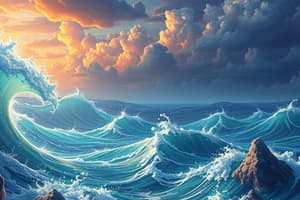Podcast
Questions and Answers
What is the primary driver of deep-water currents?
What is the primary driver of deep-water currents?
- Density differences (correct)
- Wind stress
- Coriolis force
- Tides
Which of the following is NOT a characteristic of ocean currents?
Which of the following is NOT a characteristic of ocean currents?
- Direction is always towards the equator (correct)
- Depth ranges from surface to abyssal zones
- Speed varies from 0.05 to 5 km/h
- Occur in both surface and deep waters
What is the result of Ekman transport in the Northern Hemisphere?
What is the result of Ekman transport in the Northern Hemisphere?
- Deflection upwards
- Deflection to the left
- No deflection
- Deflection to the right (correct)
What is the primary effect of upwelling on ocean chemistry?
What is the primary effect of upwelling on ocean chemistry?
Which type of circulation is involved in the exchange of water between the equator and the poles?
Which type of circulation is involved in the exchange of water between the equator and the poles?
What is the result of the Coriolis force on ocean currents?
What is the result of the Coriolis force on ocean currents?
What is the primary driver of wind-driven circulation?
What is the primary driver of wind-driven circulation?
What is the effect of meridional overturning circulation on global climate?
What is the effect of meridional overturning circulation on global climate?
Which of the following is an effect of upwelling on coastal climate?
Which of the following is an effect of upwelling on coastal climate?
What is the primary driver of thermohaline circulation?
What is the primary driver of thermohaline circulation?
Flashcards are hidden until you start studying
Study Notes
Ocean Currents
- Definition: The movement of ocean water in a specific direction, driven by several factors such as wind, tides, and the Coriolis force.
- Types:
- Surface currents: driven by wind and occur in the top 400-500 meters of the ocean.
- Deep-water currents: driven by density differences and occur below 400-500 meters.
- Characteristics:
- Speed: varies from 0.05 to 5 km/h.
- Depth: ranges from surface to abyssal zones.
Wind-driven Circulation
- Definition: The movement of ocean water driven by wind stress.
- Mechanisms:
- Ekman transport: wind-driven water movement at the surface, resulting in a 90-degree deflection to the right in the Northern Hemisphere and to the left in the Southern Hemisphere.
- Ekman spiral: a helical pattern of ocean currents, with the surface current deflected to the right/left, and the deep-water current deflected to the left/right.
- Effects:
- Creates large-scale circulation patterns, such as gyres.
- Influences ocean temperature, salinity, and nutrient distribution.
Upwelling
- Definition: The upward movement of deep, nutrient-rich water to the surface.
- Causes:
- Wind-driven Ekman transport.
- Coastal geometry and bathymetry.
- Effects:
- Increases ocean productivity and supports marine life.
- Affects coastal climate and weather patterns.
- Impacts ocean chemistry and carbon sequestration.
Meridional Overturning
- Definition: The poleward flow of ocean water at the surface, with a return flow at depth.
- Characteristics:
- Thermohaline circulation: driven by density differences between warm, salty water and cold, fresh water.
- Meridional overturning circulation: a component of the thermohaline circulation, involving the exchange of water between the equator and the poles.
- Effects:
- Regulates global climate by transporting heat and nutrients.
- Influences ocean chemistry and carbon sequestration.
Thermohaline Circulation
- Definition: The deep-water circulation driven by differences in temperature and salinity.
- Mechanisms:
- Formation of deep water: occurs at high latitudes, where water is cooled and sinks.
- Deep-water flow: driven by density differences, with cold, fresh water sinking and warm, salty water rising.
- Effects:
- Regulates global climate by transporting heat and nutrients.
- Influences ocean chemistry and carbon sequestration.
- Plays a critical role in the global ocean's carbon cycle and ocean acidification.
Ocean Currents
- Ocean currents are driven by wind, tides, and the Coriolis force.
- There are two types of ocean currents: surface currents (driven by wind, occurring in the top 400-500 meters) and deep-water currents (driven by density differences, occurring below 400-500 meters).
Wind-driven Circulation
- Wind-driven circulation is the movement of ocean water driven by wind stress.
- Ekman transport and Ekman spiral are two mechanisms of wind-driven circulation.
- Ekman transport causes a 90-degree deflection to the right in the Northern Hemisphere and to the left in the Southern Hemisphere.
- The Ekman spiral is a helical pattern of ocean currents, with the surface current deflected to the right/left, and the deep-water current deflected to the left/right.
- Wind-driven circulation creates large-scale circulation patterns, such as gyres, and influences ocean temperature, salinity, and nutrient distribution.
Upwelling
- Upwelling is the upward movement of deep, nutrient-rich water to the surface.
- Upwelling is caused by wind-driven Ekman transport and coastal geometry and bathymetry.
- Upwelling increases ocean productivity, supports marine life, affects coastal climate and weather patterns, and impacts ocean chemistry and carbon sequestration.
Meridional Overturning
- Meridional overturning is the poleward flow of ocean water at the surface, with a return flow at depth.
- Thermohaline circulation is driven by density differences between warm, salty water and cold, fresh water.
- Meridional overturning circulation regulates global climate by transporting heat and nutrients, and influences ocean chemistry and carbon sequestration.
Thermohaline Circulation
- Thermohaline circulation is the deep-water circulation driven by differences in temperature and salinity.
- Formation of deep water occurs at high latitudes, where water is cooled and sinks.
- Deep-water flow is driven by density differences, with cold, fresh water sinking and warm, salty water rising.
- Thermohaline circulation regulates global climate by transporting heat and nutrients, influences ocean chemistry and carbon sequestration, and plays a critical role in the global ocean's carbon cycle and ocean acidification.
Studying That Suits You
Use AI to generate personalized quizzes and flashcards to suit your learning preferences.




